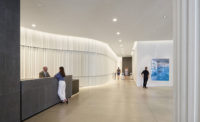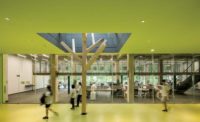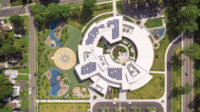During a recent reception at the midtown-Manhattan office of COOKFOX Architects, celebrating the firm’s completion of the Neeson Cripps Academy— a 40,000-square-foot secondary school in Phnom Penh, Cambodia—partner Richard Cook described visiting that city’s Stung Meanchey landfill in 2008. At the time, he saw children, many of them abandoned by their parents, roaming the sea of festering trash in this 100-acre facility—now closed, but located near the site of the new school—looking for scraps to sell. “Some piece of me was left there that day,” he said.
The Cambodian genocide carried out by the Khmer Rouge regime between 1975 and 1979 left a legacy of poverty (the landfill scavenging being just one example) and ruptured families so extensive that it can still be felt and seen today. “The impact will go on for generations,” says Cook, whose ties to the country are personal and professional. He and his wife adopted twin Cambodian boys in 2002, and COOKFOX designed the Friends Center for the Angkor Hospital for Children, Cambodia’s leading pediatric-care facility, which was completed in 2008.
Additional Content:
Jump to credits & specifications
The Neeson Cripps Academy, the most recent addition to the firm’s pro bono portfolio, was completed in February 2017 and serves 400 children per year, ranging in age from 13 to 18. Established to provide a high-quality education for Phnom Penh’s most disadvantaged children, the school offers a robust English-language program, STEAM subjects (Science, Technology, Engineering, Art, and Math), and access to the latest digital technologies. Many of the children who gleaned on the landfill are now students at the Academy. The thoughtfully designed L-shaped building sits on what was a tract of land strewn with garbage and plastic bags, and ringed with ad hoc dwellings.
The design team split the school building into two wings. One, a long concrete volume oriented east–west, contains five floors of open-air classrooms. It is raised a level above grade to create a protected arcade—particularly important during Cambodia’s rainy season—that leads to a courtyard. A second, fully enclosed, terra-cotta-block volume to the northwest contains the school’s science and technology labs, which require highly efficient mechanical systems that keep the equipment in a tempered environment. Deep horizontal and vertical terra-cotta fins shade its low-E coated glass window wall (the floor slabs extend outward for further solar shading).
“One of the challenges was making a building that was state-of-the-art while still reflecting forms and materials that were familiar and recognizable to the neighborhood,” says COOKFOX partner Pam Campbell. The open-air wing, she says, is a nod to Cambodia’s wonderful modernist architecture, from before the Khmer Rouge rampage. A delicate and environmentally friendly bamboo screen shades its southern facade. The material is also used to surface the ceilings of the arcade and interior lobby.
Another driver was the need to create a building that could be easily maintained, says Campbell, which led her team to minimize the need for mechanical ventilation, and to use local materials and construction methods. The rooftop includes a sports court and a teaching garden with native plants and vegetables, which minimize solar heat gain and reduce stormwater runoff. A solar array provides a portion of the school’s energy needs.
The client, the Cambodian Children’s Fund (CCF), was founded by Scott Neeson in 2004 after visiting the same landfill that moved Cook. For Neeson, a Hollywood marketing executive at the time, a chance visit to the dump while on vacation led him to sell his Los Angeles house and furnishings, move to Phnom Penh, and found CCF. Since then, he has opened five other schools in Cambodia and created networks to help families manage debt, receive health care, develop job skills, and find housing. Originally, CCF’s goal was to help the 45 children that Neeson first met at the landfill; today more than 2,200 kids are enrolled in its educational programs.
Named for both Neeson and Robert Cripps, former group chairman of Velcro Companies, which donated the building to CCF, the Neeson Cripps Academy was much needed to fill a gap in the web of support that the not-for-profit organization has stitched together over the past 13 years. Neeson takes pride in the fact that the “poorest children in Cambodia” will now be able to attend “the best school.”
CreditsArchitect: COOKFOX Architects / 250 West 57th Street, New York, NY 10107 / 212-877-0287 / www.cookfox.com
Personnel in architect's firm who should receive special credit: Principal Architects: Rick Cook, FAIA Pam Campbell, LEED AP BD+C Design Team: Ciarán Conlon, LEED AP BD+C Tyler Caine, AIA, LEED AP BD+C Mark Canfield Marguerite Lefevre Giacomo Vischi
Interior designer: COOKFOX Architects
Engineers: MEP: Optima Consultants Ltd. Structural: iLi Consulting Engineers Mekong Ltd. (Design) / Arcadia (Thailand) Co. Ltd. (Construction)
General contractor: Advance Construction and Design
Construction management: ACH Management (Cambodia) Co., Ltd.
Photographer: David Yeow, www.davidyeow.com |
SpecificationsExterior Cladding Curtain wall: Teasco (Thailand)
Windows Metal frame: Teasco (Thailand)
Glazing Glass: Teasco (Thailand)
Conveyance Elevators/escalators: Schindler Elevator
Plumbing Bathroom fixtures: American Standard
Energy Photovoltaic system: Arcadia Engineering |














Post a comment to this article
Report Abusive Comment